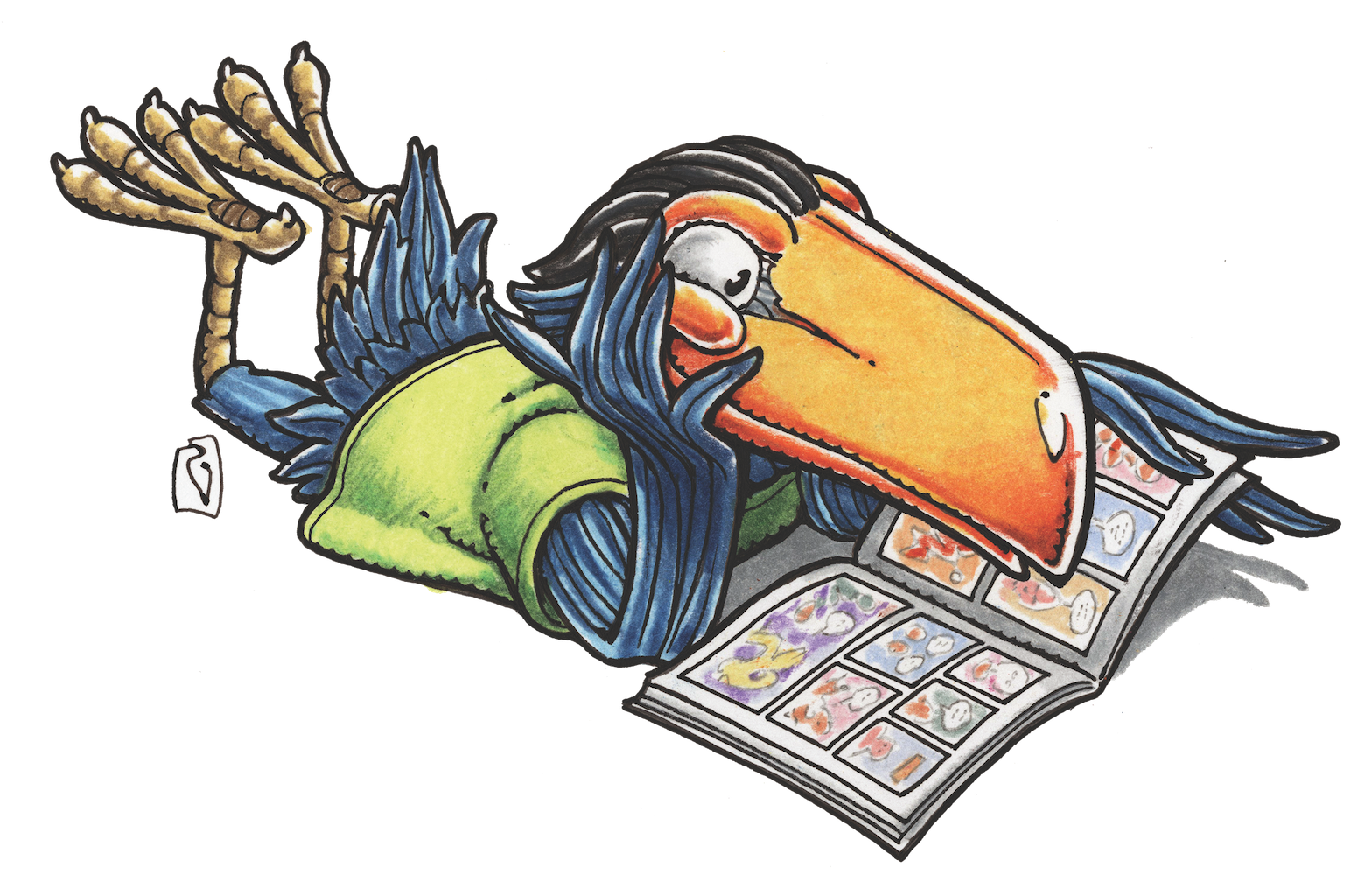STEVE LIEBER’S DILETTANTE
Dilettante 023: Influences


Last weekend I was riding Amtrak back from a convention when my train was delayed by a freight train. Stuck there in a comfortable seat with only 10,000 calories of tasty snack food close at hand, two good e-books, and four strong bars of free wifi, I wondered how I could possibly endure such difficulty. That’s when it occurred to me that I could get on Twitter and do an AMA: Ask Me Anything.
I received a bunch of great questions in my timeline and via direct message, and tried to answer them all, but it turned out I missed a good one: “Who has had the greatest influence on your work and why?”
I’d like to be able to laugh dismissively at this question, and wave it off with a proclamation that I’m self-made, and that my only influence is nature sculpted by warm sunlight, but that would be self-serving nonsense. Like most of my peers, I’m a Frankenstein-ed hodgepodge of countless influences, some actively studied, some passively absorbed, and some consciously rejected. Here are a few influences that had a big impact on my work.
1. Joe Kubert
I wrote a short tribute to Joe a couple of years ago. He remains one the most important influences on my work. I read and copied pictures from his comics as a kid and studied at his school for three years. My first jobs in comics were a caveman story, a western, some war stories, and Hawkman, material closely associated with Joe’s body of work. At first, my drawing displayed a lot of his surface mannerisms. I didn’t try to make my stuff look like his, but frequently at school I’d bring my crappy classwork to him for a critique, and he’d lay a piece of tracing paper over what I had done and show me things that would make my work better. As he did this, I’d see the ideas come to life, but in his line. The next time I sat down to draw, I’d instinctively reach for his solutions. It took me a few years to shake that surface off. Fortunately if you do anything ten hours a day for years, you’ll start to find your own ways to do it.
The more significant influence Kubert had on me was his way of thinking about storytelling. He was matter-of-fact about what each panel needs to achieve, and showed me how to analyze what I want to communicate in a panel and on a page. These included things like what an establishing shot is, and how it’s used to tell the reader where this story takes place and what kind of story they’re reading. He showed me the value of clear staging, and why I’d want to set the reader’s point-of-view in one place vs. another. I learned to think of panels like sentences in a paragraph, each one adding new information and building towards a moment that would keep the reader interested enough to turn the page.
2. Robert Fawcett
Gil Kane once described himself as having been a young artist with too many influences, like being an overloaded airplane, weighed down and unable to take off until he jettisoned some weight. I felt the same, and was lucky to find a book that helped me sort through what was a worthwhile influence and what was just clutter: On the Art of Drawing by Robert Fawcett.
Fawcett’s book isn’t a “How-To-Draw” textbook. It barely even acknowledged that such things exist (though he helped author one of the best: The Famous Artists School course). His own book was more of a “Why-To-Draw” book, an extended essay on how to think about drawing: what drawing is for, and what are worthwhile goals for a draftsman. He stressed the importance for students to have a humble eye, to learn by observation. And he offered the best definition of good draftsmanship I’ve seen:
“The essence of good draftsmanship seems to be to make oneself understood on paper. It deals with clarification rather than confusion, and substitutes meaningful delineation for vagueness and indecision.”
Fawcett also taught me to distinguish between the powerful simplicity of a master draftsman and the arbitrary and glib simplifications of a stylist. I’d known for a long time that simplicity was an important goal, but I didn’t really grasp what was so hard about it. It’s not difficult to make a simple drawing. What’s difficult is making it communicate as much as one that’s elaborate and detailed.
(Fawcett’s work was for a long time out of print. Now it’s back. Dover Publications has reprinted On The Art of Drawing and David Apatoff has written a lavishly illustrated biography of the artist.
3. Lynda Barry
My drawing looks nothing like Lynda Barry’s, but her approach to storytelling profoundly affected my understanding of comics. Before reading her work, I mostly thought of the text in comics as an aid to the pictures. We use captions and dialogue because some things can be said more clearly or efficiently with text than with pictures. Lynda Barry taught me just how powerful it can be when the words and pictures act in counterpoint: words saying one thing, pictures another, and a third meaning coming from their juxtapostion. I also learned from her how much you could do with subjective pictures. In comics, pictures are mostly read as objective: the pictures function as statements of the facts of the story. Barry’s use of pictures offers other possibilities. Sometimes they’re there to provide a mood or an idea that supports or undercuts what we’re told in the text. Sometimes they illustrate what a character is daydreaming while the text conveys the reality. Sometimes they tell a seemingly unrelated parallel story, creating ambiguities that leave room for the reader to figure out how they might be related.
Stories often have the most impact when the point isn’t spelled out and the reader is allowed to put things together in their own head. Barry is a master of that.
4. Harvey Kurtzman
Kurtzman understood better than just about anyone that comics are a rhythmic form. Reading his war comics and the early issues of MAD helped me understand so much about pace and rhythm. I learned the impact you can get by changing the number of panels on a tier. How you can affect timing by including or eliminating a caption or a sound effect. How you can make a moment pop by switching from curving shapes to angular, or by juxtaposing the cluttered with the sparse. And he showed how valuable it can be to break the rule of thumb that says that in adventure stories you have to keep moving the “camera.” The usual idea is to switch angles to keep the reader’s eye interested and create a sense of movement. Kurtzman shows what you can achieve by maintaining a static point of view in a sequence of panels, changing only one element, and thereby emphasizing how important that one element is.
5. Jaime Hernandez
Technically, Jaime Hernandez’s work is an impeccably crafted synthesis of wildly disparate elements: Dan DeCarlo, Hank Ketcham, Charles Schulz, John Stanley, Jack Kirby, and Alex Toth, to name a few. But what are more interesting are his razor sharp eye for human behavior, his wit, his restraint, and his ability to use traditional comics tools with new results. He manages to communicate a much wider and deeper range of characters, feelings, images and ideas than most cartoonists. He stripped away my notion of the limits of comics. And it was from reading his work that I learned that you can shift between naturalistic and cartoony without loosing the reader’s sense of immersion, that you can get laughs out of juxtaposing something recognizably human with something larger than life, and if you know your characters, you can make them interesting even when they aren’t doing things that advance the plot.
So those are five important influences on my work. I’d love to answer any further questions you might have. And I’m really eager hear some of your influences. Share them with me on Facebook or Twitter or post them on Tumblr and tag me.
Steve Lieber’s Dilettante appears the second Tuesday of every month here on Toucan!